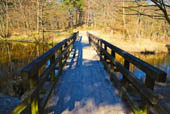
Purpose
To construct a paper bridge that is strong enough to support several "vehicles" while demonstrating the force of tension.
Additional information
Structures, such as bridges, are anything that can support it's own weight in addition to weight of other objects against gravity. There are two kinds of forces provided by weight: compression and tension. Compression is the force that causes the pushing down and tightening of the structure. Tension is opposite of compression and is the pull that causes the stretching of the structure. Triangles support both compression and tension. As compression is pushing down on the sides of the triangle, the base is pulled up equally in two directions, causing tension.
Sponsored Links
Required materials
- Two even sized wooden blocks
- Several standard sheets of writing paper
- Several coins (pennies, nickels, dimes, and quarters)
Estimated Experiment Time
5 or more minutes (depending on how many bridges you need to construct).
Step-By-Step Procedure
- 1. Place the blocks on a solid surface, such as a floor or table. Place them about 6 inches apart.
- 2. Create a paper bridge using one of the sheets of paper. You can fold the bridge any way you like! The goal is to make it sturdy enough to hold several coin "vehicles".
- 3. With your bridge folded, place it on the wooden blocks so that it spans the length of the bridge evenly.
- 4. One by one, place your coin "vehicles" in the center of the bridge on your "roadway". Do not place the coins on the wooden blocks.
- 5. How many coins was your bridge able to support before it collapsed?
- 6. Repeats steps 2 through 5, this time folding the bridge in a different manner. The goal is to find the best fold of the bridge so that it will support the most coin "vehicles" before it collapses.
- 7. Which one of your paper bridges was the strongest and could hold the most coin "vehicles"?
Note
Do not put any weights or support on the ends of the wooden blocks to hold the bridge down. The bridge should be placed to lie freely across the blocks. Also make sure to stack the coins only in the center of the bridge.
Observation
What would happen if you were to move the blocks further apart or closer together? What other materials could you use to form your bridge?
Result
Did you create a bridge with a corrugated roadway, similar to the folds of a paper fan? If so, you created a very sturdy bridge! The alternating bends and folds form triangular ridges which form the strongest structure as all three sides equally bear the load.
Sponsored Links
Take a moment to visit our table of Periodic Elements page where you can get an in-depth view of all the elements,
complete with the industry first side-by-side element comparisons!